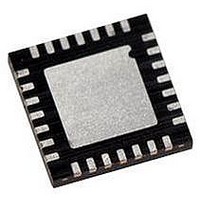PIC16LF723A-I/ML Microchip Technology, PIC16LF723A-I/ML Datasheet - Page 118

PIC16LF723A-I/ML
Manufacturer Part Number
PIC16LF723A-I/ML
Description
MCU PIC 3.5K FLASH XLP 28-QFN
Manufacturer
Microchip Technology
Series
PIC® XLP™ 16Fr
Specifications of PIC16LF723A-I/ML
Core Size
8-Bit
Program Memory Size
7KB (4K x 14)
Peripherals
Brown-out Detect/Reset, POR, PWM, WDT
Core Processor
PIC
Speed
20MHz
Connectivity
I²C, SPI, UART/USART
Number Of I /o
25
Program Memory Type
FLASH
Ram Size
192 x 8
Voltage - Supply (vcc/vdd)
1.8 V ~ 3.6 V
Data Converters
A/D 11x8b
Oscillator Type
Internal
Operating Temperature
-40°C ~ 85°C
Package / Case
28-VQFN Exposed Pad, 28-HVQFN, 28-SQFN, 28-DHVQFN
Controller Family/series
PIC16LF
No. Of I/o's
25
Ram Memory Size
192Byte
Cpu Speed
20MHz
No. Of Timers
3
Lead Free Status / RoHS Status
Lead free / RoHS Compliant
Eeprom Size
-
Lead Free Status / RoHS Status
Lead free / RoHS Compliant, Lead free / RoHS Compliant
- Current page: 118 of 284
- Download datasheet (3Mb)
PIC16F/LF722A/723A
14.1
The capacitive sensing module can monitor up to 16
inputs. The capacitive sensing inputs are defined as
CPS<15:0>. To determine if a frequency change has
occurred the user must:
• Select the appropriate CPS pin by setting the
• Set the corresponding ANSEL bit
• Set the corresponding TRIS bit
• Run the software algorithm
Selection of the CPSx pin while the module is enabled
will cause the capacitive sensing oscillator to be on the
CPSx pin. Failure to set the corresponding ANSEL and
TRIS bits can cause the capacitive sensing oscillator to
stop, leading to false frequency readings.
14.2
The capacitive sensing oscillator consists of a constant
current source and a constant current sink, to produce
a triangle waveform. The CPSOUT bit of the
CPSCON0 register shows the status of the capacitive
sensing oscillator, whether it is a sinking or sourcing
current. The oscillator is designed to drive a capacitive
load (single PCB pad) and at the same time, be a clock
source to either Timer0 or Timer1. The oscillator has
three different current settings as defined by
CPSRNG<1:0> of the CPSCON0 register. The different
current settings for the oscillator serve two purposes:
• Maximize the number of counts in a timer for a
• Maximize the count differential in the timer during
14.3
To measure the change in frequency of the capacitive
sensing oscillator, a fixed time base is required. For the
period of the fixed time base, the capacitive sensing
oscillator is used to clock either Timer0 or Timer1. The
frequency of the capacitive sensing oscillator is equal
to the number of counts in the timer divided by the
period of the fixed time base.
14.4
To measure the frequency of the capacitive sensing
oscillator, a fixed time base is required. Any timer
resource or software loop can be used to establish the
fixed time base. It is up to the end user to determine the
method in which the fixed time base is generated.
DS41417A-page 118
CPSCH<3:0> bits of the CPSCON1 register
fixed time base
a change in frequency
Note:
Analog MUX
Capacitive Sensing Oscillator
Timer Resources
Fixed Time Base
The fixed time base can not be generated
by the timer resource the capacitive
sensing oscillator is clocking.
14.4.1
To select Timer0 as the timer resource for the capacitive
sensing module:
• Set the T0XCS bit of the CPSCON0 register
• Clear the T0CS bit of the OPTION register
When Timer0 is chosen as the timer resource, the
capacitive sensing oscillator will be the clock source for
Timer0. Refer to Section 11.0 “Timer0 Module” for
additional information.
14.4.2
To select Timer1 as the timer resource for the
capacitive sensing module, set the TMR1CS<1:0> of
the T1CON register to ‘11’. When Timer1 is chosen as
the timer resource, the capacitive sensing oscillator will
be the clock source for Timer1. Because the Timer1
module has a gate control, developing a time base for
the frequency measurement can be simplified using
either:
• The Timer0 overflow flag
• The Timer2 overflow flag
• The WDT overflow flag
It is recommended that one of these flags, in conjunc-
tion with the toggle mode of the Timer1 gate, is used to
develop the fixed time base required by the software
portion of the capacitive sensing module. Refer to
Section 12.0 “Timer1 Module with Gate Control” for
additional information.
TABLE 14-1:
TMR1ON
0
0
1
1
TIMER0
TIMER1
TMR1GE
TIMER1 ENABLE FUNCTION
0
1
0
1
2010 Microchip Technology Inc.
Count Enabled by input
Timer1 Operation
Off
Off
On
Related parts for PIC16LF723A-I/ML
Image
Part Number
Description
Manufacturer
Datasheet
Request
R

Part Number:
Description:
IC PIC MCU FLASH 8KX14 28-SPDIP
Manufacturer:
Microchip Technology
Datasheet:

Part Number:
Description:
IC PIC MCU FLASH 8KX14 28-QFN
Manufacturer:
Microchip Technology
Datasheet:

Part Number:
Description:
IC PIC MCU FLASH 8KX14 28-SPDIP
Manufacturer:
Microchip Technology
Datasheet:

Part Number:
Description:
IC PIC MCU FLASH 8KX14 28-QFN
Manufacturer:
Microchip Technology
Datasheet:

Part Number:
Description:
IC PIC MCU FLASH 8KX14 28-SOIC
Manufacturer:
Microchip Technology
Datasheet:

Part Number:
Description:
IC PIC MCU FLASH 8KX14 28-SSOP
Manufacturer:
Microchip Technology
Datasheet:

Part Number:
Description:
IC PIC MCU FLASH 8KX14 28-SSOP
Manufacturer:
Microchip Technology
Datasheet:

Part Number:
Description:
7 KB Flash, 16 MHz Int. Osc, NanoWatt XLP 28 SOIC .300in TUBE
Manufacturer:
Microchip Technology
Datasheet:

Part Number:
Description:
IC PIC MCU FLASH 2KX14 28SOIC
Manufacturer:
Microchip Technology
Datasheet:

Part Number:
Description:
IC PIC MCU FLASH 2KX14 28QFN
Manufacturer:
Microchip Technology
Datasheet:

Part Number:
Description:
IC PIC MCU FLASH 2KX14 28DIP
Manufacturer:
Microchip Technology
Datasheet:

Part Number:
Description:
IC MCU FLASH 2KX14 28SOIC
Manufacturer:
Microchip Technology

Part Number:
Description:
IC PIC MCU FLASH 2KX14 28QFN
Manufacturer:
Microchip Technology

Part Number:
Description:
IC PIC MCU FLASH 2KX14 28SSOP
Manufacturer:
Microchip Technology
Datasheet:

Part Number:
Description:
IC, 8BIT MCU, PIC16LF, 32MHZ, QFN-28
Manufacturer:
Microchip Technology
Datasheet:










